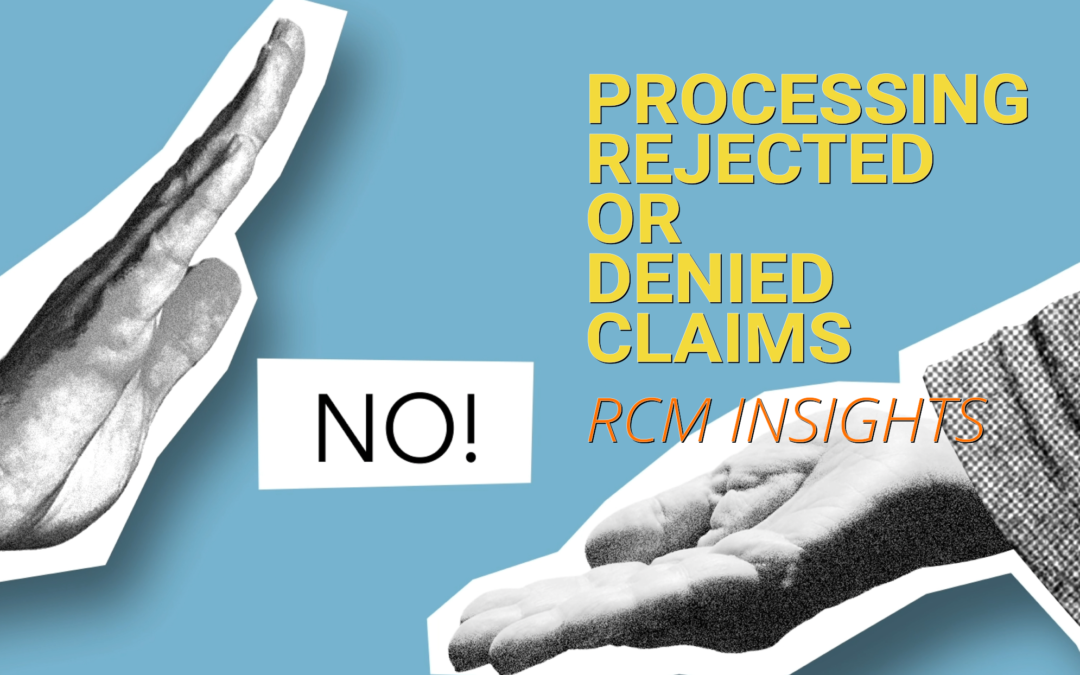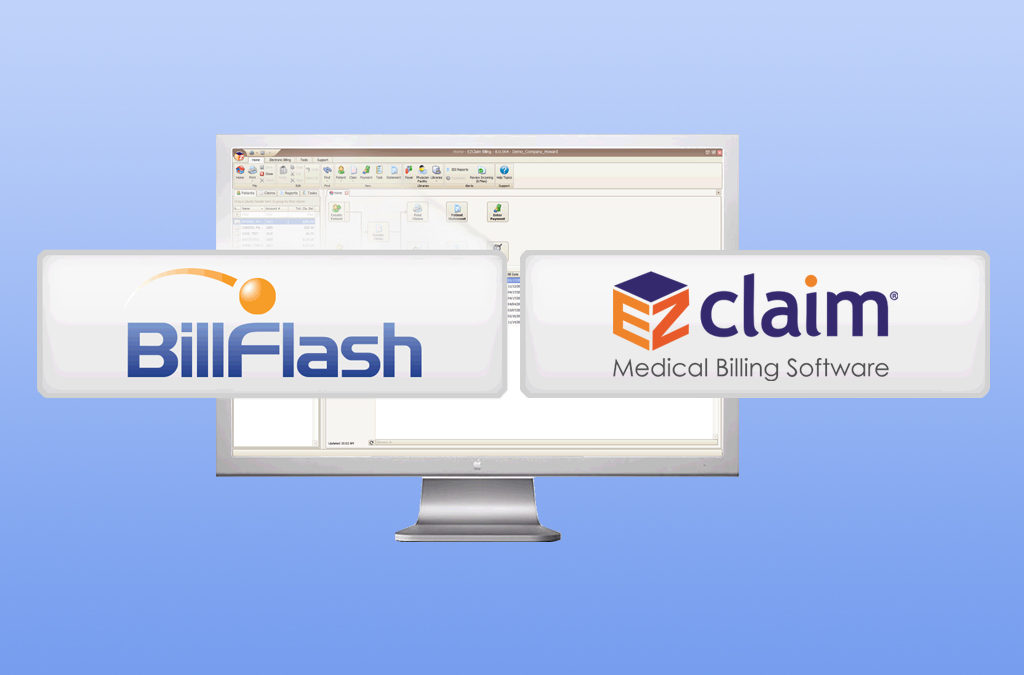
May 18, 2021 | Denied Claims, RCM Insight
Last month we looked at tools for getting clean claims out the door on the first try. Many billers or practices stop monitoring claims once the leave the practice management program, but this is where you are likely losing money. The unfortunate truth is you need to use the tools available to you to catch rejected and denied claims to ensure proper and timely payment. Today we will look at rejections and denials, and the resources you have (or need) to work efficiently.
The terms rejection and denial are used interchangeably in the billing world but they have distinct differences, including how you are notified. Let’s start with defining the differences.
Rejected Claims
- Claims can be rejected by the clearinghouse OR the payer
- Rejections are based on submission guidelines
- Rejected claims have not been entered into your payers system for adjudication
- Notified through a claim status report (ANSI 277) that comes back into most practice management programs from the clearinghouse
- Corrections do not require a resubmission code
Denied Claims
- Claims are denied by your payer
- Denials are based on policy coverage
- Denials have been accepted for adjudication and deemed unpayable
- Notified on remittance advice (ANSI 835/ERA)
- Payers may require a resubmission code and original reference number when submitting a corrected claim
If you are using a clearinghouse and receiving your claim status reports electronically, you will be notified quickly about rejected claims. There are two ‘checkpoints’ that will look for errors. The first is your clearinghouse, the second is the payer.
At each checkpoint claims will be Rejected or Accepted, these status updates come to you through a claim status report. If your practice management system is able to process these reports (ANSI 277) your claims will be updated with the accepted or rejected information you will be able to correct any rejected claims within your practice management system. When you see an error, start with checking who has rejected your claim. This will be the point of contact if you have questions about the rejection or how to correct it. If you are not already, make it a daily task to get your reports, correct any rejected claims, and resubmit those claims.
When a claim has been accepted by your clearinghouse and the payer it enters the adjudication system. This is where the payer will make a determination on payment based on the members coverage and your contract. The denials will appear on your remittance advice with a payment or as a zero dollar payment, indicating that they have reviewed your claim and they have determined no payment is applicable. If you are enrolled with you payer for electronic remittance advice (ERA) this file will come electronically and your practice management system will be able to list or identify denied claims. These claims will either need to be researched further for clarification on the denial or written off. It is vital that your practice management system can handle these scenarios appropriately so you do not lose money for payable services.
This is another scenario where technology can seem scary. However, efficiently monitoring and working is well worth the learning curve. If you are already sending electronically and not using the claim status report or electronic remittance advice – coordinate with your clearinghouse and practice management system to find out how these reports can save you time and money.
If you would like more information on creating workflows for rejections, denials, or enrolling with a clearinghouse, let RCM Insight help! Visit us at www.rcminsight.com to request a consultation.
[Contribution by Stephanie Cremeans with RCM Insight]

Apr 5, 2021 | Claim Status Inquiry, Claims, Denied Claims, RCM Insight
If a medical billing program has “scrubbing,” why did my medical billing claim still get denied? It is a common question that we are going to answer today.
First, let’s get a better understanding of the words we are talking about. In the medical billing world, validation and scrubbing tend to be used interchangeably. While they are similar – they are not actually the same. Understanding what you have and what you need will help you submit ‘clean’ claims.
According to Technopedia, data validation checks for the integrity and validity of data and ensures the data complies with the requirements. So, what requirements? Often people assume that this means payer requirements, but that is typically not standard. Validation rules are built into your practice management software and can be used for several points. Following are some common rules you may find in your program:
- Ensure NPI‘s and Tax IDs are the appropriate lengths
- Ensure patients date of birth is entered
- Ensure that a procedure code and place of service are present on each claim
While these scenarios are standard across the industry, there may be other situations that a validation rule can help. Some programs will allow you to create custom rules for your practice. A customized validation rule will allow you to create a rule for a payer requirement. For instance, you could create a rule to prevent the following:
- Do you have a code that always requires a modifier, but only for a specific payer?
- Work with pediatrics and always need the ‘relationship to insured’ to read something other than self
- How about insurance ID numbers that are a specific alpha-numeric combo, like 3 letters followed by 9 digits?
Keep in mind, if you are creating validation rules the program will make sure that the criteria are met based on the rule entered into your software. When creating custom rules, it is important to note that this will not verify payer billing guidelines. You will need to obtain information directly from your payer to create a rule that coincides with their policies.
Once any validation errors have been addressed your claims will go to the clearinghouse you are working with. Most clearinghouses offer claim scrubbing for an additional fee. Technopedia defines data scrubbing as the procedure of identifying and then modifying or removing incomplete, incorrect, inaccurately formatted, or repeated data.
Claim scrubbing is available in several ways. It may be used within your practice management system, your clearinghouse, or even a third-party vendor. Claim scrubbing services can vary greatly in what they are looking for.
Once the claim has left your practice management system it will likely go through at least 2 scrubbing programs—one with the clearinghouse and one with your payer, prior to accepting the claim for processing. When claims are found to have an error, these results are sent back through a Claim Status Report (ANSI 277 file or a human-readable text file). This report will include information about why the claim cannot be processed. This report will also indicate whether it is the clearinghouse or the payer that is rejecting the claim. If you have further questions about the rejection, you will need to contact the entity that has rejected it.
Checking the Claim Status Reports on a regular basis will help you correct the errors and resubmit in a timely manner. In addition, the information you have gathered from the rejections can be used to update internal processes or create customized validation rules to prevent future rejections for the same error–saving you time and money!
RCM Insight is a medical billing company that uses EZClaim’s medical billing software. For any details that have to do with claims validation and “scrubbing,” contact RCM Insight directly.
ABOUT EZCLAIM:
EZClaim is a medical billing and scheduling software company that provides a best-in-class product, with correspondingly exceptional service and support. Combined, they help improve medical billing revenues. To learn more, visit EZClaim’s website, e-mail them, or call them today at 877.650.0904.
[ Contribution by Stephanie Cremean’s with RCM Insights ]

Apr 5, 2021 | BillFlash, collections, Credit Card Processing, Denied Claims
With patient payment responsibility increasing each year, medical practices need to be extra diligent in collecting patient payments. This includes sending accounts to collections when necessary. Fortunately, there are steps you can take to make collections easier and more effective—both of which contribute to more revenue for your practice.
Here are three ways to improve your medical billing collections.
1. Be clear about your payment expectations
Make sure patients know when they will be expected to pay, and what payment methods you accept. Collecting copays before each visit is one of the best ways to avoid having accounts sent to collections, so making payment a part of the check-in process is a good idea. Post signs throughout the office to keep bills top of mind for patients. The more reminders you give patients about their payment responsibility, the less you will have to deal with collections.
2. Reach out to patients who have stopped paying
Keep an eye on delinquent accounts. If an account is approaching 30-60 days past due, it’s time to reach out to the patient. Try to have an empathetic conversation to see what you can do to help them pay off their bill. If they are experiencing financial difficulties, offer to adjust the payment terms to something more suitable to their situation. Even if it means you are only collecting part of their payment now, both the practice and the patient will be better off in the long run.
3. Automate what you can
The collections process is slow and cumbersome—if you’re doing everything manually. Software like BillFlash Integrated Collection Services saves your staff a lot of time by handling the manual processing for you. After that, all you need to do is approve which accounts to send to collections, based on the aging and amounts you prefer, and a collections expert will get to work collecting your revenue.
So, visit one of EZClaim’s partners, BillFlash, to learn more about how BillFlash Integrated Collection services can improve your medical billing collections.
ABOUT EZCLAIM:
As a medical billing expert, EZClaim can help the medical practice improve its revenues since it is a medical billing and scheduling software company. EZClaim provides a best-in-class product, with correspondingly exceptional service and support. Combined, EZClaim helps improve medical billing revenues. To learn more, visit EZClaim’s website, email them, or call them today at 877.650.0904.
[ Contribution from the marketing team at BillFlash ]

Feb 9, 2021 | Claim Status Inquiry, Claims, Denied Claims, Electronic Billing, Medical Billing Software Blog, Partner, Waystar
Reducing claim denials has long been a challenge for providers. In the worst case, denied claims end up as unexpected—and sometimes unaffordable—bills for patients. The challenge only seems to be growing. A recent survey conducted by the American Hospital Association (AHA) found that 89% of respondents had seen a noticeable increase in denials over the past three years, with 51% describing the increase as “significant.”
Minimizing loss will be top of mind for providers as the COVID-19 pandemic continues to put a strain on their resources, and minimizing or preventing denials will need to be a core part of that strategy. With that in mind, we’re offering four tips to help guide revenue cycle strategies for better denial reduction in 2021.
1. Analyze and Assess
In order to achieve and maintain a healthier denial rate, it’s vital to have a good handle on the factors creating problems in the first place. Keep the following in mind as you start to structure your analysis:
- Review key performance indicators: Take a look at which metrics are being used to benchmark success or failure and see if it’s time for a refresh
- Evaluate workflows: It’s important to have a clear understanding of how your team operates, and that you can detail workflows as step-by-step processes
- Assess tools: Inventory the software you’re using and discuss with your team how it helps or hinders them
- Staff efficiency: Consider the number of team members and resources involved in each step of the denial management process
It’s also important to talk to staff. Your team can offer invaluable insight on what is and isn’t working to help you develop a more comprehensive understanding of the shape and scope of the systemic issues contributing to your denial rate.
2. Reduce Errors Upfront
Eligibility, registration, and authorization errors remain the greatest cause of denials and write-offs, so a good first step is to focus on being proactive instead of reactive. Often, it’s easy to get into a routine where errors are only addressed after they occur. But incorporating tech to verify coverage and benefit accuracy in advance can lead to higher efficiency and much less manual labor spent to correct those issues later on.
Similarly, a recent AHA report found a failure to obtain prior authorization to be one of the most common reasons for a claim to be denied by a commercial health plan. In another recent survey, the American Medical Association found that 86% of providers surveyed were struggling with a high administrative burden created by prior authorizations.
Recent innovations have made the process simpler than ever. The right prior authorization solution can automate the process and make it simpler, smarter, and much less labor-intensive, reducing manual input errors and preventing denials.
3. Cut Down on Manual Labor
Claim denials are often the result of staff trying to keep track of a seemingly overwhelming number of rules and regulations while juggling various systems and filing requirements. When your staff is overburdened, it’s that much easier for them to make simple errors or miss deadlines.
There are numerous tools available for teams who are either struggling with paper-based processes or databases without automation. With an AI-powered solution, you can streamline a number of time-consuming tasks while simultaneously automatically ensuring you’re identifying missing data or claim errors that can be corrected before they’re submitted.
It’s also a good idea to review any potential new tools with your team. Their insight will help you properly determine which solutions will actually improve their workflows, and which could prove an expensive time sink.
4. Use Stronger Reporting Tools
Accurate and in-depth reporting should be core to your strategy. Effective reporting tools let you quantify and assess the issues that influence your denial rate, allowing you to easily spot persistent workflow errors or other systemic problems that can create extra work or strain resources.
New tools powered by AI and machine learning offer more robust reporting options than ever, with advanced analytics and visualization capabilities that make it easy to explore complex data sets or identify trends. Mountains of information can now be easily managed and measured, giving you access to operational insights that will help you better understand problem areas and identify opportunities for improvement.
The Wrap-up
With the right tools, a solid strategy, and expert guidance, you can take a proactive approach to reducing claim denials. Our automated tools make it easy for your team to streamline their workflows while reducing errors and administrative costs. With Hubble, our AI and RPA platform, you can unlock the insights you need to reduce your denial rate and increase cash flow.
Waystar, a partner of EZClaim, also offers a number of front-end solutions to help you take a more proactive approach to your denial rate. Click here to learn more about how Waystar can help you with reducing claim denials and claim management. For more information about Waystar’s platform, visit their website, or give them a call at 844.492.9782.
To find out more about EZClaim’s medical billing software, visit their website, e-mail their support team, or call them at 877.650-0904.
[ Contribution: Waystar ]

Dec 14, 2020 | AMBA National Conference, Claims, Cloud Security, Denied Claims, EZClaim Cloud, EZClaim Premier, Medical Billing Customer Service, Medical Billing Software Blog
Deborah Rieser founded Spectrum Medical Billing Services in Anchorage, Alaska 15 years ago to make extra money to help with paying the family’s bills. Today, she owns a thriving medical billing service with a team of “twelve lovely ladies”—as she likes to refer to them—that services clients nationwide. Rieser originally selected EZClaim’s medical billing software platform—because of its pricing structure—to use for her medical billing service.
Over the years, since her original purchase, she has upgraded to each new EZClaim version, which adding new features and efficiencies. Recently, she has made the transition to EZClaim Cloud, and continues to use it exclusively today.
With team members nationwide, Rieser prides herself on training her billers on properly classifying billing for medical offices so that there are minimal insurance denials. She is very particular about this since one of the reasons Deborah began billing was the insurance qualification struggles she had for her daughter with Autism. So, accurate billing is ‘personal’.
Recently, we found time to interview Rieser about her start in the industry, the ups and downs of being a business owner, and what hard-fought expertise she has gained that might help others considering to start their own medical billing service.
EZCLAIM: When did you get into the medical billing industry and why?
RIESER: “I always had an entrepreneurial spirit, and I had an orchid business out of our house. Then my daughter, who was born with Autism, started working with an Occupational Therapist (OT), and they came to me to help with billing. I thought about it, and after a few weeks, I took it on. That was back in 2005.
“At that time, my daughter had over 75 volunteers and therapists in the community work with her from age three to age five, and had 50-60 hours a week of therapy. Today, she is a sophomore in university, has a boyfriend, is driving her car, and is thriving. From all of that, I have always felt the need to give back to the community for all their help. So, I used my business to take on other Pediatric, Occupational Therapy, Physical Therapy, and Speech Therapy clients, as well as, using my experience to help patients take care of their billing needs and get their bills paid by insurance.”
EZCLAIM: What are you passionate about when it comes to billing?
RIESER: “For me, the biggest thing that I am passionate about is seeing my clients [medical offices] getting paid from insurance claims. I also enjoy helping patients get properly classified during medical visits, so claims are accepted. I have learned a lot from the mistakes and errors that have led to denied claims. From my experience, I can help medical practices observe their approach to patients’ needs so that services qualify when billing insurance companies. Being able to offer that to my clients is very satisfying.”
EZCLAIM: What are some of the challenges you have had to overcome?
RIESER: “Originally, we grew word-of-mouth. I didn’t even want a website at first, but now I do have one. Going from one client to 65 is challenging because as your clients grow, your staff grows. Recently, I lost a client. You then have to decide what you’re going to do with your staff. The hardest part is that, for a business owner, your business consistently goes up and down. That fluctuation can be stressful. For me, I deal with that by going outdoors. My husband and I will go for a walk in nature and that will help relieve my stress.”
EZCLAIM: What advice would you offer others in the billing industry that have similar experiences?
RIESER: “If you’re starting your own business, make sure it’s one you love. Know that there will always be highs and lows. Also, be sure to price yourself accordingly. You can’t go too high or people will look elsewhere.
“I do want to step back and highlight that some of my billing practices only do 2-3 claims a week, and that’s why I love EZClaim. The price of the software. When I was growing, I was working on EZClaim “Advance,” which is being retired. So, when I started looking around at other software providers, they were billed on a ‘per provider cost.’ Fortunately, EZClaim “Cloud” billed based on the number of concurrent users, which worked for me.”
EZCLAIM: How has your relationship with AMBA (American Medical Billing Association) benefitted you?
RIESER: “I just joined last year in 2019, thanks to EZClaim and Dan Loch’s referral. I love that group. I joined their Facebook group because they have very useful information for us billers. I recommended that my team members join as well. They are good at supporting US-based companies and put the focus on supporting the group.”
EZCLAIM: What would you tell people who are wondering if EZClaim Cloud is right for them?
RIESER: “The transition to EZClaim Cloud was easy. I was worried about the providers and the tax ID’s, but it all was very smooth. I would add that customer support was very helpful. As daunting as moving things over felt, it was very smooth. I attribute that to the planning and support.”
EZCLAIM: What would you say would be a strength of someone who is good at billing and coding?
RIESER: “It is important to be a very good communicator, professional, out-going, and enjoy what you do. One must be able to communicate with providers over denials, success, celebrations, and always keep talking with the staff and the providers. Also, always try to put yourself in the patients’ shoes by offering patience and compassion. Lots of times patients don’t understand their benefits and why they are denied. So, try to explain in layman’s terms. They understand better and appreciate that. It ends up being a good connection with the patient, and benefits you as the biller, too.”
EZCLAIM: Final thoughts?
RIESER: “I am grateful to EZClaim for their services. As a business owner, you have to monitor expenses and things can add up fast. So, I am thankful for EZClaim Cloud and its pricing structure. That has helped Spectrum Medical Billing Services to grow and thrive.”
[ The above answers were paraphrased as closely as possible to the original answers given by Deborah Rieser on November 25, 2020 ].
ABOUT EZCLAIM:
EZClaim is a medical billing and scheduling software company that provides a best-in-class product, with correspondingly exceptional service and support. Combined, they help improve medical billing revenues. To learn more, visit EZClaim’s website, e-mail them, or call a representative today at 877.650.0904.

Nov 10, 2020 | Alpha II, BillFlash, Claims, collections, Denied Claims, EZClaim Premier, HIPAA, Medical Billing Software Blog, Revenue, Support and Training
It IS POSSIBLE to improve medical billing revenues, and here are a few ways to do just that.
Healthcare practitioners, whether established or just starting out, have many overwhelming tasks: Managing a practice; Seeing patients; Working to staying up-to-date on administrative tasks; The whole host of compliance at the federal, state, and local level; and Overseeing the billing.
One of these that can lead to loss of revenue is not properly managing the medical billing, which can also lead to HIPAA fines and rejected claims. However, there is a solution: a medical billing system that balances the budget and optimizes revenues of medical practice.
EZClaim, an expert in the medical billing software market since 1997, provides a solution that improves the efficiency of an office’s billing process in many ways. The following are the primary reasons.
Reduce Coding Errors
Medical procedures become codes, codes become claims, and claims become revenue. Any error in this process can make claims to be denied, your workload can be increased, and revenue can be lost. To help in avoiding errors, it is essential to use billing software that offers the easiest implementation and access to descriptive diagnosis and treatment codes. EZClaim’s medical billing solution offers ease-of-use in coding, billing, and strong partnerships with Clearinghouses which act as an additional ‘safety net’ for catching errors.
Administrative Support
Most medical practices are a small team of people tackling a wide range of tasks, so when one cannot understand the function of the billing software, accessing reliable support is very important. EZClaim prides itself on having dedicated support experts available, and that was how the company was established. Founder and President Al Nagy has said, since day one, “We are a support company that happens to sell medical billing software.”
Maintain Industry Compliance
It is important to recognize that industry compliance and a practice’s revenue go hand-in-hand. Filing and batching inaccurate and non-HIPAA compliant claims can often be traced back to an outdated healthcare revenue management system. Conquering these tasks requires a focus on multiple fronts: A properly trained billing team, clear office procedures, patient payment policies, and a reliable medical billing company. These are all ways to help buttress against non-compliance and rejected claims.
Streamline Workflow
Recently, a study was done that showed almost 80% of medical bills contain errors. These incorrect medical claims often end up as lost revenue originally, not to mention the additional cost of resubmissions and collections. One of the best ways to resolve this problem for your practice is to make use of both well-trained, experienced billers and coders, combined with a competent medical billing solution that aids in catching these errors. EZClaim software features a library of standard validation, the ability to add custom validation, and integrates with Alpha II for full claim scrubbing.
Follow up
Errors will and do occur, so establishing a system for follow-up on all denials will close the loop and protect against lost revenue. Being consistent with the follow-up process, and having a medical billing solution that tracks these things will help close that gap.
Collections
Finally, probably the most important aspect that optimizes a practice’s revenue is to get paid. Portals and payment collection systems definitely help with this, but having collections integrated into the medical billing system is, of course, the best. EZClaim has pain-free payment processing integrated into their solution, called EZClaimPay. It solves all the problems associated with payment processing: Bank deposits, reconciliation, statements, changing fees, and ‘finger-pointing’ when there is a problem. EZClaimPay’s robust platform will greatly increase a practice’s collections success, and improve their revenue.
———————————-
ABOUT EZCLAIM:
EZClaim is a medical billing and scheduling software company that provides a best-in-class product, with correspondingly exceptional service and support, and can help improve medical billing revenues. To learn more, visit their website, e-mail them at sales@ezclaim.com, or call a representative today at 877.650.0904.
[ Photo credit: Studioarz ]









